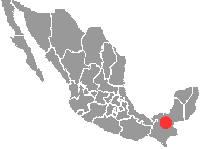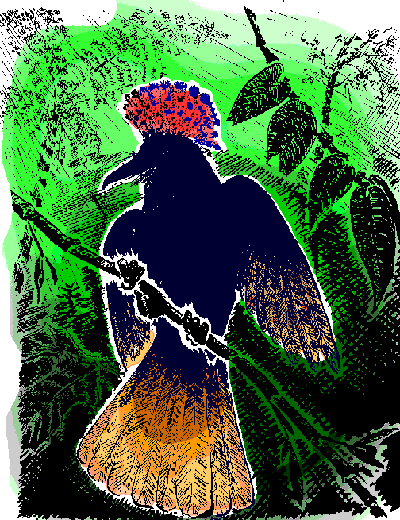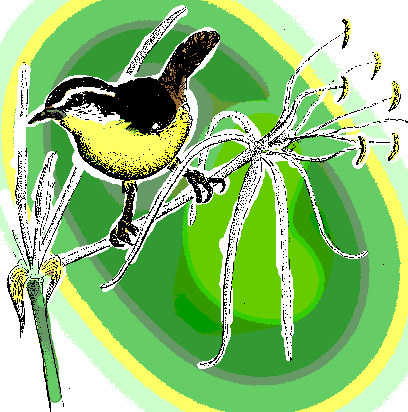 For
at least the 20th time in my life now I take a series of buses across the Gulf lowlands to
the ancient Maya ruin of
Palenque in the northeast corner of Mexico's southernmost state of Chiapas. On my very
first trip into Mexico, when I hitchhiked through the entire country back around 1968, I
came here riding in the back of a pickup truck, for at that time no bus service was
available and the ruin was not well known. Back then the landscape here struck me as
"deep jungle." At the ruin I rented a kerosene lantern and all by myself descend
into the Temple of
Inscriptions, and for as long as I wanted viewed the famous stone sarcophagus lid with
its fantastic, otherworldly carvings and hieroglyphics. Now the ruin's stairway is
electrically lit and I'm told you don't get more than a few seconds of viewing.
For
at least the 20th time in my life now I take a series of buses across the Gulf lowlands to
the ancient Maya ruin of
Palenque in the northeast corner of Mexico's southernmost state of Chiapas. On my very
first trip into Mexico, when I hitchhiked through the entire country back around 1968, I
came here riding in the back of a pickup truck, for at that time no bus service was
available and the ruin was not well known. Back then the landscape here struck me as
"deep jungle." At the ruin I rented a kerosene lantern and all by myself descend
into the Temple of
Inscriptions, and for as long as I wanted viewed the famous stone sarcophagus lid with
its fantastic, otherworldly carvings and hieroglyphics. Now the ruin's stairway is
electrically lit and I'm told you don't get more than a few seconds of viewing.
I like Palenque because there are cheap camping sites near the ruins and the
ruins themselves lie next to bird-filled tropical evergreen forest about as good as you
can find in Mexico.
After buying several days of food and cartons of milk in the town of
Palenque, I take a microbus toward the ruins and get off at my usual campground, Maya
Bell, which during most of my visiting years has been about as laid-back and mellow a
place as you can find anywhere, always with a few guitar-strumming hippies from the north
less interested in the ruins than the hallucinogenic "magic mushrooms," genus Psilocibe,
growing so commonly in the pastures across the road. Today as I walk in, probably
beginning my last stay here in my life, my feeling of nostalgia is profound, and I'm
saddened to see how the place has "cleaned up," with fewer hippies now, and more
white-haired gringos in air-conditioned campers. Still, good tropical evergreen
forest stands nearby, and the cost for a tent site isn't high.
Not long before sunset, as soon as I get my tent pegged beneath a huge Strangler
Fig tree at the campground edge, right next to the forest, I sit down on one of
the fig's rambling roots and look around. Some American
Redstarts seem immune to the late afternoon heat as they nervously forage
through the lower forest canopy gleaning leaves and stems with their small, slender beaks.
From inside a dense heap of vines and bushes comes the familiar wahhh call of the
Gray
Catbird. Hopping along the rusty barbwire fence between the campground and
the forest, right above a line of leafcutter ants, is a Magnolia
Warbler. The vegetation is unmistakably tropical, but these first birds are
all "old friends from home."
RUIN BIRDS
While the great bus-brought masses stream into and out of the Temple
of Inscriptions' front entrance, it's possible to sit on the pyramid's back side in fair
solitude, gazing at ease into the extremely lush, dense forest just behind the temple.
Since the cutting of trees is not allowed around the ruins, the vegetation here is about
as mature as you can find in these parts. Also, a little footpath leads back behind the
Temple, up the hill and along a valley, to an Indian village on the hill's other side.
This footpath is wonderful for birding. Here are the species noted on the day I visit the
ruins:
BIRDLIST #14-a
November 26:
latitude 17º30'N, longitude 92º02'WMEXICO: Chiapas; forest and forest edges
around ruins of Palenque
RESIDENCY STATUS:
winter resident
not found in the USA
- Keel-billed Toucan
- White-crowned Parrot
- Citreoline Trogon
- Chestnut-colored Woodpecker
- Boat-billed Flycatcher
- Northern Royal Flycatcher
- Masked Tityra
- Brown Jay
- Gray Catbird
- Yellow-throated Vireo
- Black-and-white Warbler
- Black-throated Green Warbler
- Blue-winged Warbler
- Hooded Warbler
- Magnolia Warbler
- Wilson's Warbler
- American Redstart
- Montezuma Oropendola
- Red-throated Ant-tanager
All the species seen are either familiar migrants from North America, or birds not found
at all north of the US/Mexico border.
FIREBIRD
In the middle of the morning, very hot, getting tired,
on a steep slope inside dense vegetation, about to give up birding for the day, I lean
against a tree, raise my head, and see exactly what I sketch above. In a sunbeam, a Northern
Royal-flycatcher spreads its crest, fans its tail and opens its wings, causing an
explosion of living light, a transcendent moment.
In a split second, the crest disappears, the wings and
tail jerk into their usual configuration, and in the next second the bird is gone.
If I were a Maya shaman in another time and age, what
kind of sign might this be?
I have never experienced such an exquisite instant of
being with a bird.
RAIN BIRDS
This is supposed to be the beginning of the dry season here but the
day after my ruin visit heavy rains come and go all day and all the following night. It's
a warm rain but everything I have gets wet or at least moist, and already mildew is
setting in.
Between downpours I walk around seeing what I can see. The American
Redstarts continue being particularly active and easy to see.
Down next to the office red-flowered hibiscuses and cannas are in full blossom and how pretty
to see these gaudy flowers visited by the green-backed Long-tailed
Hermit hummingbirds, with their two very elongated, white, central tail
feathers and very long-curved bills. Despite these birds' being much larger than any
hummer we have in North America, and shaped much different, this is a common species in
lowland forests and humid second growth from southern Mexico to the Amazon drainage.
Down among the gringo RVs, brownish Clay-colored
Robins hop about on the mowed grass just like American Robins farther north. But
the day's prettiest bird is surely the Masked Tanager, slinking through
the dense, wet herbage at the campground's edge, almost invisible among the shadows, its
body mostly black, but with a sky-blue rump and wing patch, and a "hood" over
its head of a rich golden hue. With its Rembrandt colors it seems to have been designed to
harmonize with the luxuriant forest-edge wet-glossiness it sticks to. It's found from here
into South America.
On a massive Strangler-fig limb I watch a male and female Yellow-throated
Euphonia, also members of the Tanager Family. The male orbits the female
moving its body on its legs exactly as might a teenage boy exhibiting how to thrust the
pelvis back and forth during sex, but in an exaggerated, humorous-looking manner.
FENCE-JUMPER
With the rains making the forest hard to get through and with my
shoes falling apart anyway, the road between town and the ruin is a fair place to bird
from, and even here you see amazing things.
I hear a quick weezit, look to my right and there's a
little thick-billed bird so dark blue that it might as well be black, the Blue-black
Grassquit. The crazy thing is that this bird is perching on a barbed-wire
fence and each time it makes its weezit call it jumps into the air a good foot
and a half, then instantly returns to its former spot. It does this every five to ten
seconds so it's an amazing display.
Moreover, to me it sounds as if this bird's voice is ventriloquial
-- as if the song originates a couple of feet behind the bird. However, my books say
nothing about this, so maybe I'm just having hearing problems. Maybe the rains are
stopping up an ear.
CAR-USING KISKADEE
A car crashes into a dragonfly, leaving the shattered insect on the
road. A stocky, yellow-bellied, dark-rusty-backed flycatcher, a Great
Kiskadee, shoots from the roadside thicket, snatches up the meal, returns to
a shadowy perch and eats.
Through the binoculars I admire the bird's colors and fine features.
It's a very common bird, a "weed bird" distributed in disturbed sites from
southern Texas to Argentina. Hearing another car coming, the kiskadee's body language
shows that the bird is paying attention. He holds his head so that his right eye faces the
road. The car passes, no insect is left on the road, and the kiskadee "loosens
up," changes position, looks around -- until the next car, and then the same routine
is repeated, with his right eye fixed hard on the road.
After three cars pass he very vigorously, almost brusquely, wipes
his bill and looks around. Anyone not ashamed of interpreting bird behavior
anthropomorphically would say that this bird is frustrated because not every car leaves
behind a shattered dragonfly.
MIGUEL'S ROADRUNNER
Some days the rain comes so hard that even walking along the road is
pointless. Many of the campers, including myself, are so wet and mildewed that the
experience is losing its charm. To distract himself from the mess, one day Miguel
Antillón Carreón from the Mexican state of Jalisco drops by my sagging tent for a chat.
He's noticed that I'm watching birds and he has a bird story.
One day between Jalapa and Presa Teotitlán he was visiting a campesino,
a farmer, and saw a Greater Roadrunner eating with the chickens, and behaving in every way
like a chicken. The campesino explained that he had stumbled upon a roadrunner's
nest, stolen an egg, put it in the nest of a brooding hen, and now the roadrunner thought
it was a chicken. Miguel says that he always looked for that roadrunner when he passed by
that place, and that it stayed there for eight months, then disappeared.
THE SQUIRREL CUCKOO'S LONG TAIL
At Témoris we saw that the Black-throated Magpie-jay's long tail
sometimes gave it problems when the wind was stiff. The Squirrel Cuckoo,
a large, rusty-red bird common in a variety of habitats from northern Mexico to Argentina,
also has a substantial tail, not as long as the Magpie-jay's, but thicker, and pretty long
as well. One day I see one example of how the 18-inch-long (46 cm) cuckoo deals with its
ample tail.
The bird perches at the very top of a medium-size, compact tree. The
tree's topmost branches form a fairly regular surface and the cuckoo simply rests its tail
flat upon that surface as he looks around.
BIRDLIST #14-b
On the US's Thanksgiving Day, the rain holds off long enough for me
to walk along the road between town and the ruins, making the following list:
November 28:
latitude 17º30'N, longitude 92º02'WMEXICO: Chiapas; along road, around ranchos
and trees of Maya Bell Campground, and just below ruins of Palenque
RESIDENCY STATUS:
winter resident
not found in the USA
- Black Vulture
- Turkey Vulture
- Gray Hawk
- Roadside Hawk
- Short-tailed Hawk
- Plain Chachalaca
- Cattle Egret
- Squirrel Cuckoo
- Groove-billed Ani
- Long-tailed Hermit
- Rufous-tailed Hummingbird
- Aztec Parakeet
- White-fronted Parrot
- Golden-fronted Woodpecker
- Golden-olive Woodpecker
- Great Kiskadee
- Masked Tityra
- Montezuma Oropendola
- Brown Jay
- Blue-gray Gnatcatcher
- Clay-colored Robin
- Bananaquit
- Black-and-white Warbler
- Kentucky Warbler
- Magnolia Warbler
- Orange-crowned Warbler
- Yellow Warbler
- Common Yellowthroat
- Gray-crowned Yellowthroat
- Northern Parula
- American Redstart
- Melodious Blackbird
- Montezuma Oropendola
- Great-tailed Grackle
- Orchard Oriole
- Yellow-tailed Oriole
- Blue-gray Tanager
- Masked Tanager
- Scarlet-rumped Tanager
- Yellow-throated Euphonia
- Blue-black Grassquit
- White-collared Seedeater
- Black-headed Saltator
Noteworthy is the real abundance of Wilson's
Warblers, with American Redstarts and Magnolia Warblers being very common as well. Even
when it's raining these species busily forage among the bushes and trees. What a treat to
see the redstart so busy de-bugging a big, deeply palmately lobed cecropia leaf,
a kind of leaf very unlike anything the bird sees during the nesting phase of its life up
North.
 One of
the most spectacular birds in the list is also one of the most "jungly sounding"
ones, a fairly large bird (the male being about 20 inches long -- 50 cm), the Montezuma
Oropendola shown at the right. My Peterson field guide describes its bubbly,
haunting song as being "like water pouring out of a bottle: 5-7 liquid glub's
or gloob's, getting higher and faster." The one in my drawing is hanging on
its nest, so you might guess that oropendolas are closely related to orioles who build
similar pendulous nests. Sometimes you see large, isolated trees in pastures in which
several such large nests are hanging, and it's quite a sight. Despite the bird being so
spectacular, it's somewhat commonly encountered.
One of
the most spectacular birds in the list is also one of the most "jungly sounding"
ones, a fairly large bird (the male being about 20 inches long -- 50 cm), the Montezuma
Oropendola shown at the right. My Peterson field guide describes its bubbly,
haunting song as being "like water pouring out of a bottle: 5-7 liquid glub's
or gloob's, getting higher and faster." The one in my drawing is hanging on
its nest, so you might guess that oropendolas are closely related to orioles who build
similar pendulous nests. Sometimes you see large, isolated trees in pastures in which
several such large nests are hanging, and it's quite a sight. Despite the bird being so
spectacular, it's somewhat commonly encountered.
One Magnolia Warbler becomes famous in the
campground for attacking its reflection again and again in the side mirror of a pickup
truck from Maryland. This goes on the whole morning except for a five-minute period when a
Great Kiskadee comes driving the warbler away so he can attack his own
image in the same mirror. Several mirrors are available in this campground so one wonders
what is so special about this one.
BANANAQUIT & BEYOND
 For
at least the 20th time in my life now I take a series of buses across the Gulf lowlands to
the ancient Maya ruin of
Palenque in the northeast corner of Mexico's southernmost state of Chiapas. On my very
first trip into Mexico, when I hitchhiked through the entire country back around 1968, I
came here riding in the back of a pickup truck, for at that time no bus service was
available and the ruin was not well known. Back then the landscape here struck me as
"deep jungle." At the ruin I rented a kerosene lantern and all by myself descend
into the Temple of
Inscriptions, and for as long as I wanted viewed the famous stone sarcophagus lid with
its fantastic, otherworldly carvings and hieroglyphics. Now the ruin's stairway is
electrically lit and I'm told you don't get more than a few seconds of viewing.
For
at least the 20th time in my life now I take a series of buses across the Gulf lowlands to
the ancient Maya ruin of
Palenque in the northeast corner of Mexico's southernmost state of Chiapas. On my very
first trip into Mexico, when I hitchhiked through the entire country back around 1968, I
came here riding in the back of a pickup truck, for at that time no bus service was
available and the ruin was not well known. Back then the landscape here struck me as
"deep jungle." At the ruin I rented a kerosene lantern and all by myself descend
into the Temple of
Inscriptions, and for as long as I wanted viewed the famous stone sarcophagus lid with
its fantastic, otherworldly carvings and hieroglyphics. Now the ruin's stairway is
electrically lit and I'm told you don't get more than a few seconds of viewing.

 One of
the most spectacular birds in the list is also one of the most "jungly sounding"
ones, a fairly large bird (the male being about 20 inches long -- 50 cm), the
One of
the most spectacular birds in the list is also one of the most "jungly sounding"
ones, a fairly large bird (the male being about 20 inches long -- 50 cm), the 